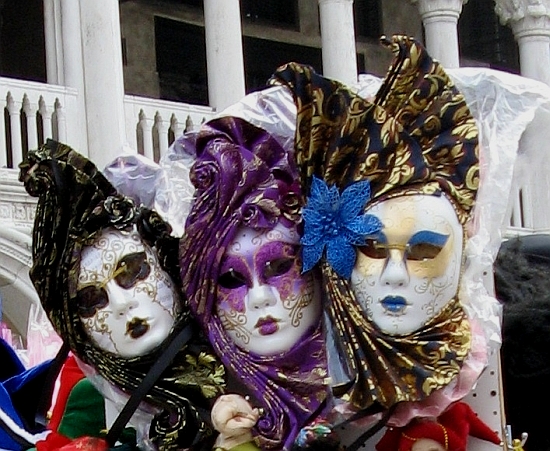Search results
56 results found.
56 results found.
The first day of autumn came and went as decreed by the cosmos, but around here summer didn’t get the memo. The heat wave that began some two months ago is still enjoying itself thoroughly, lolling on the beach, gleaming on the Alpine peaks, bringing joy to the daring hoteliers who risked staying open and not unconsiderable damage to the farmers.
It was the hottest September on record; on average, nearly 3 degrees above the norm. In Piemonte, Torino registered 30 degrees C (86 degrees F), a September temperature it hasn’t felt since 1753. Rainfall has become a distant memory.
The farmers are not amused. Not only are the crops lollygagging along for lack of rain and excess of heat, but the harvest, whenever they manage to make it, is going to be puny. Ten percent fewer grapes, and they’re already fermenting — unheard of. Tomatoes and olives and rice are down 20 percent.
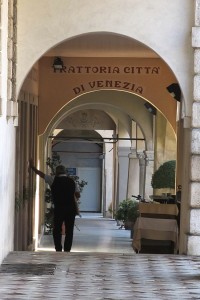
But one crop is still going strong: The Adriatic beaches continue to pullulate with tourists even though the kiosks are closed and the lifeguards have all gone home. Some wag had his picture taken under his big umbrella holding a batch of chestnuts, two seasonal icons which have never met and probably never even heard of each other.
But let’s make the proverbial hay while the proverbial sun is still proverbially glowing. Even though school started two weeks ago, Gianni Stival, vice-mayor of Caorle (a beach town) is dreaming of a bumper crop of late vacationers and has proposed — not for the first time — that the Veneto postpone the first day of school for two whole weeks.
“It would be good for tourism,” he explains, “because now when the first school bell rings at the middle of September, families are compelled to go home.” And take all their money with them. Never mind if little Bepi never learns the names of the European capitals or the definition of plankton or that when a girl says “no” she’s pretty likely to have meant “no” (oh wait — they don’t teach that). Whatever is good for tourism is, by definition, good for everybody, assuming that little Bepi has somehow learned to count past 20. Or maybe that doesn’t matter either, now that cash registers calculate the correct change.
Last Saturday we decided to become tourists, in our own small way, so we took the train to Conegliano, a small but prosperous provincial town just 58 km (36 miles) from Venice. Conegliano is famous for Prosecco and a painter named Giovanni Battista Cima (1460-1518), nicknamed “da Conegliano,” or “from Conegliano,” so we don’t confuse him with all those other Giovanni Battista Cimas.
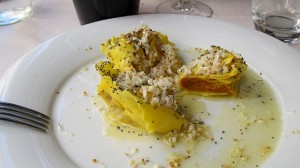
It was a heavenly day — sorry for the farmers, but we loved it, even though we were thwarted in our intention to browse the weekly market, which spreads along the main street and its tributaries offering everything from socks to handmade baskets. Don’t assume that Saturday has been ordained by God, or the mayor, as the perfect day for a big market. Turns out they hold it on Friday. In case you ever need to know.
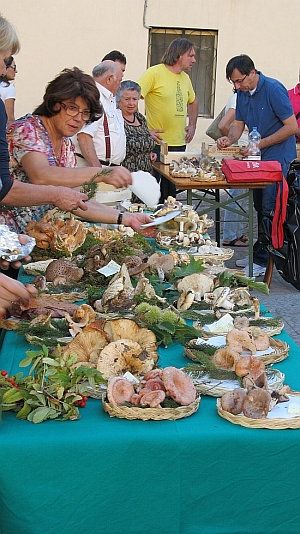
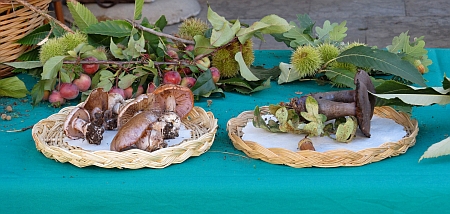
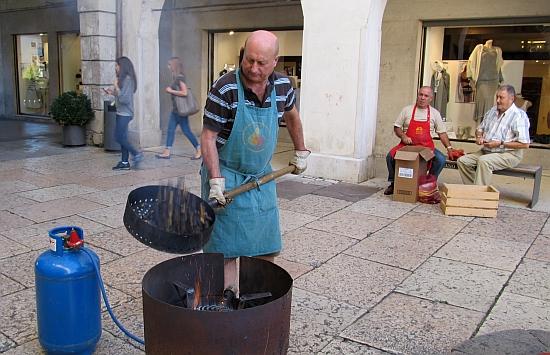
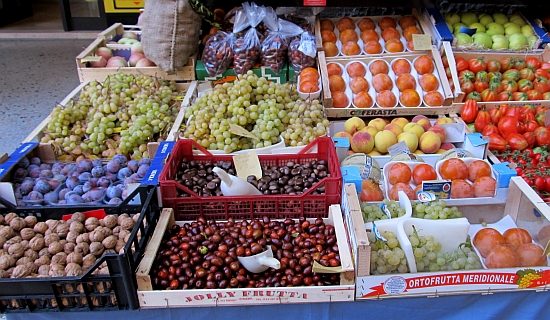

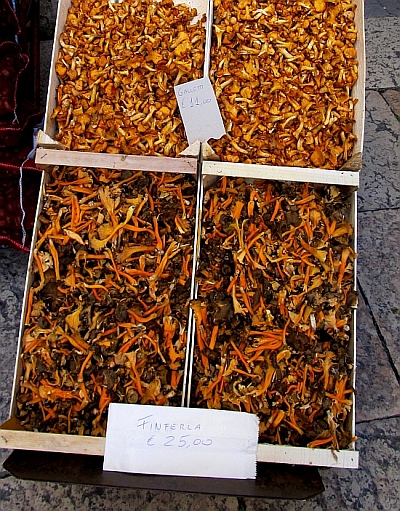
The last two weeks of August here contain some of the most predictable events ever found on earth, right up there on the list next to sunrise and the last Saturday at WalMart before school starts.
Our predictable events in this period are the preparations for the Venice Film Festival (this year August 31 to September 10), which involve what always look like amazingly late and chaotic preparations of the main theatre known as the Palacinema and its environs, plus truckloads of complaints and accusations of waste and inefficiency from everybody except the organizers. There are also preparations for the Regata Storica, whose five days of eliminations conclude tomorrow, which proceed in a more organized way. This may be because they are, in fact, better organized, or only because they entail fewer people and matter less to the world at large, by which I mean there’s less money involved.
But these are events which you can ignore if you’re not particularly interested. What nobody can ignore is the afa.
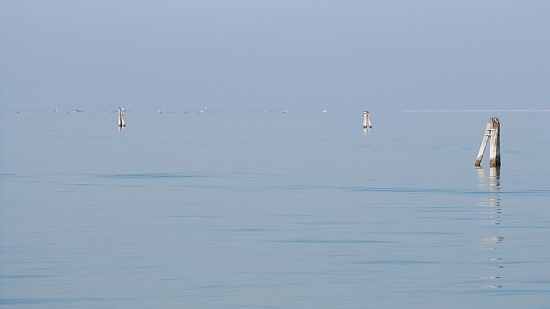
The afa currently sucking the life out of the lagoon and its denizens also qualifies as an annual event and you don’t even have to go to it. It comes to you. “The afa came down like a wolf on the fold,” as Lord Byron didn’t say, and its cohorts, if it had any, are definitely not gleaming in purple and gold. They’re not gleaming at all, theyre practically naked and most of them are neck deep in the exhausted tepid water of the Adriatic.
In fact, a morning view of either the sea or the lagoon gives the impression that these bodies of water are not made of water at all, but of glycerine, heavy and smooth, a colorless liquid that barely has the strength to form even the tiniest wave.
I know how it feels. When the alarm sounds in the shapeless sodden dawn, the term “primordial ooze” comes to mind, by which I don’t mean the world, I mean me. It isn’t a good feeling to be either primordial or oozy and to be both is depressing even if I know that evolution will eventually bring me the opposable thumb and the sextant and the sonnets of Shakespeare.
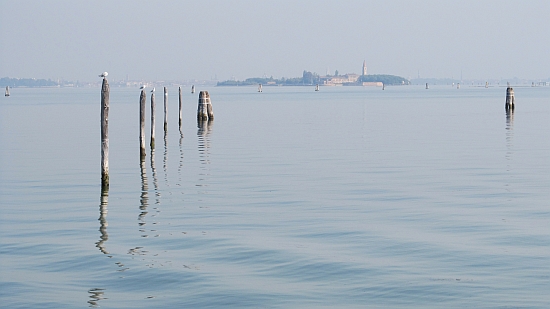
A Saharan front is pressing down on the Veneto region and also much of the rest of the old Belpaese, and it’s the longest and hottest heatwave around here for the last 20 years. Good for beach tourism, I suppose, though not good for other activities like farming.
One Bosnian truckdriver was completely unimpressed by all this. He stopped in a supermarket parking lot at Crocetta del Montello near Treviso yesterday, and all that sunshine immediately made him think of catching some of those rays.

So he climbed up onto the roof of his cab, I suppose on some kind of towel to avoid completely crisping, with a supply of drinks at hand. Voila! His own little beach!
Then he took off all his clothes and stretched out. Evidently Bosnian truckers hate those bathing-suit lines as much as anybody.
A cashier in the supermarket saw the naked man tanning himself up there and called the Carabinieri. End of tan.
I don’t know if Venice has ever experienced a monsoon, but I can tell you we’re all waiting for one.
I recently promised, somewhat insincerely, to report on how the race of the Four Ancient Maritime Republics came out last Sunday. Insincere, because even though I have seen it here and, via television, elsewhere, I’ve always had the impression that it was a race that interested only the people taking part. I certainly wasn’t picking up any tremors of curiosity from that part of me that wonders about everything.
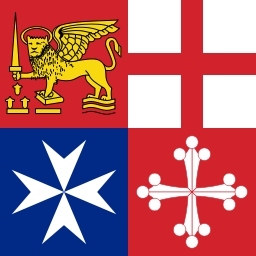

But we did watch most of it, standing on a mid-course bridge, and about one minute into the 8-minute, 2000-meter contest we had the winner all picked out (the team from Pisa, which has won the last two races, though Amalfi was rowing as if each man had a dagger clenched in his jaws). Although rowing backwards has little appeal for me personally, I had to admire the teams, composed in large part of Italian champions loaded with national, European, and even World titles. For them, this wasn’t some picturesque little jaunt, it was a real race.
Since we were too far away to see the finish, and we were staring straight into the late-afternoon sun, we went home.
Guess what? Those last five minutes have now made history. Not only did Amalfi launch a dazzling sprint that carried them across the finish line 3/100ths of a second faster than Pisa, an hour later the judges decided that three of the four competitors had to be disqualified for technical errors.
This made Venice, the obvious loser trailing for the entire race, the only possible winner.
So the judges and mayors of the four contending cities had a big meeting, while outside some of the fans were so near to starting a small riot that the police and the Carabinieri had to be called in to settle things down. Meanwhile the live-TV commentators trolled the exhausted, baffled and emotional racers for remarks. Everybody was waiting.
The verdict: The race was annulled. For the first time in the 56 years of this competition, there was no winner. It never happened. We were never there. You were just imagining it.
“Venice can’t win this way,” said mayor Giorgio Orsoni in the best sporting tradition, even though it’s a bitter bite, as they say here, when the home team loses, especially when the home team has won more of these races (30) than its three competitors put together.
So what went wrong? I will resist giving you all the details but simply say that Pisa and Amalfi, battling it out in the lead, were guilty of wandering off the legal playing field, while Genova skipped a buoy it was supposed to pass in a certain way. Naturally there were reasons for these infractions which the teams struggled to justify, to no avail. Many people, even ashore, complained about the negative effect the fireboat’s wake was undoubtedly having on the two nearest boats.
So no medals, no glory, nothing but boatloads of grief for everybody, especially Amalfi, which was deservedly proud of its spectacular last-minute push to victory. Or so it thought.
Here is the race, as seen live on national television. I don’t think it’s necessary to know Italian to understand what’s going on. You merely need to have a working knowledge of brilliance, struggle, and crushing disappointment.
And that aroma you may have noticed? It’s the fragrance of revenge wafting from Amalfi, which is the host city for next year’s race.
Trivia: The race was proposed in 1949 by the president of the Tourism organization of Pisa. The fact that it wasn’t invented by an athletic group for its competitive value, but as a neat reason to dress up a shorebound contingent of costumed extras, seems a little odd. But tourists like costumes, and the sporting people can just ignore them.
The four boats were designed by the late, legendary Giovanni Giuponi (in Venice), and built by a Venetian shipyard, originally in wood, later in fiberglass.
The bow of each boat carries a stylized figurehead representing each city’s totem animal (as I think of them): The winged lion of San Marco for Venice, a dragon for Genova, an eagle for Pisa, and a winged horse for Amalfi.
The boat/team colors are: Green for Venice, white for Genova, red for Pisa, blue for Amalfi.
The boats cannot weigh less than 760 kilos (1,675.5 pounds).
The first race was held on July 1,1956, in Pisa. Logical, seeing as it was their idea.
The positions at the starting line are drawn by lot, which is the only fair way to deal with the factor of tide, current, or any other acqueous factor which would clearly help some boats while hindering others. Every city’s stretch of water for this race presents particular little problems which the coaches and coxes make every effort to recognize. As it happens, Pisa, which had the lead for almost the whole race, was rowing in the worst position. Hats off, oars up, wave your flag or handkerchief, because they deserve it.
If the teams have been here for a week, studying the course, you might well wonder how the coxes of three boats could have made the mistakes they did. Lino’s explanation: They were of course looking for the best little thread of extra current to help them, and didn’t pay attention. Or thought nobody would notice, which is my theory.
Carnival opened officially last Saturday with the parade of the “Marias.” And it opened in a super-mega-jumbo-cast-of-thousandsly way on Sunday with the “Volo dell’ Angelo,” or flight of the angel, in the Piazza San Marco.
On Saturday we personally got our first taste of Carnival by going — do not ask me why, we must have a death wish — to the Rialto market to shop, as we often do on Saturday morning.
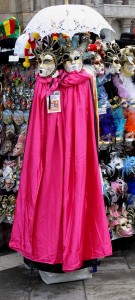
There were so many people in the city at 10:00 AM that they were being left on the vaporetto docks because the vaporettos couldn’t take any more passengers.
Let me pause here, because I don’t want to rant at random. Let me organize the current Carnival scene in as concise a way as I can. And I do this, not because I want to dash glacial water onto anybody’s fantasies of a festival which some widely distributed photographs lead you to believe is made only of dreams and glamor and a batch of feathers. No, I don’t want to do that.
But neither is it Rio or Trinidad or the Fasnacht in Basel or the Carnival in Patras or even, God help us, Mardi Gras in New Orleans. It is a strangely soulless, almost totally manufactured event which every year baffles me more than the year before, the only occurrence here which distresses Venetians more than the cost of living and the lack of affordable housing put together. I’ve lived in other cities which swarm with tourists every day (New York, Washington). The difference is that those are cities. Here, it’s like 70,000 people (official Saturday count) are trying to get into your living room.
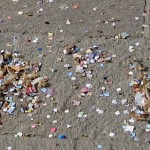
So every year I wonder why people come and what they remember when they leave — I mean, apart from the spectacular cost of everything. (A bag of confetti, 2.50 euros, or $3.50, in the Piazza San Marco, is one small example. I ask myself, why acquire pieces of colored paper just to throw them away? You’ll already be doing that with fistfuls of other colored pieces of paper issued by the European Central Bank, beginning the minute you need to pay for anything at all, from a drink to a bathroom, not to mention dinner or a bed.)

Here is what has happened so far:
Parade of the Marias — check. Lovely girls borne aloft on wooden platforms hoisted by gondoliers, and a costumed entourage, wend from San Pietro di Castello to the Piazza San Marco. Great for pictures. So far, so good.
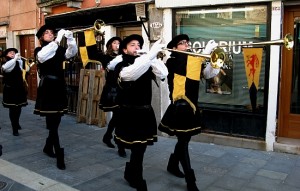
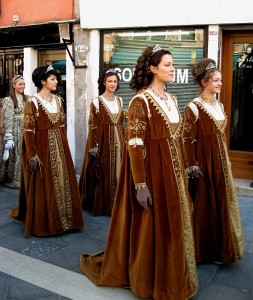
The “Flight of the Angel” — check. Under the Venetian Republic, the intrepid soul who undertook this Flying-Wallendas sort of stunt literally risked (and occasionally lost) his life. This is just a person in a costume sliding down a cable to which she has been cinched at least eight different ways. But there were 80,000 people crammed into the Piazza to watch. Great for pictures.
A “white strike.” I’m not referring to some exotic piece of performance art. It means a major slowdown — not a total strike — by the ACTV, our eccentric public transport company. In its wisdom, the first real weekend of Carnival was clearly the ideal time — two days in which the city’s population doubles — in which to make its labor grievances known, whatever they may be.
On a normal day, the ACTV skips an average of 150 runs anyway. (I’ll wait while that sinks in.) Saturday was worse, because not only did they skip runs at random, thereby creating large accumulations of people at each stop, but the vaporettos went v-e-r-r-r-r-r-y s-l-o-o-o-o-o-o-w-l-y between stops. Seeing as the workers refused to effect extra runs for the entire duration of Carnival, the city was ultimately compelled to hire a private company to provide extra service during peak hours.
Ugo Bergamo, the Assessore (councilor) for Transport, gave a brief interview to explain the situation. To the reporter’s question, “Couldn’t this have been anticipated and prevented?” Mr. Bergamo gave the astonishing reply, “A strike is supposed to create problems, otherwise what kind of a strike is it?” Mr. Bergamo didn’t feel it was appropriate to criticize the ACTV (though plenty of criticism has been made over the past year, not only for erratic service but for ticket sellers stealing money, and the deeply rooted practice of hiring relatives of employees). To him, the ACTV was far more sinned-against than sinning.
He blamed lack of money for problems which were seen as having been imposed on, not created by, the ACTV. (Translation: “Get over it.”) Rather than bring up the strike in the next City Council meeting, he wants us all to take to the barricades to protest the national and regional funding cuts which are flensing the finances of the rogue whale which is the ACTV. Not so great for pictures.
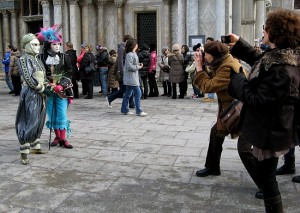
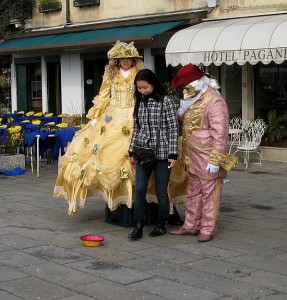
Civil unrest. It was inevitable. In the tiny hours of Sunday night/Monday morning, police and Carabinieri were called to Piazzale Roma to deal with a nascent riot. Hundreds of tired, cold, inebriated revelers had accumulated there expecting to find buses which could take them to the mainland. Well yes, there were a few — so few that the masses essentially assaulted them, while the taxi drivers had to deal with many infuriated people who considered the fares to be a ripoff. (Considering how exorbitant the fares are on a normal day, there’s no telling what the drivers were asking on a Carnival night.) After an hour or two of hard labor, calm was restored, mainly by more buses being brought into service.
“Venice on some occasions demonstrates an alarming lack of direction and coordination,” editor and reporter Davide Scalzotto remarked in an opinion piece the next day. “If this is a city that wants to be considered [as a candidate for] European Capital of Culture, they’d better think it over. That in 2011 one of the world capitals of tourism can’t manage to connect the city on the water with the mainland 24 hours a day is verging on the incredible. First they invite tends of thousands of people to a party and bring lots of money to the ‘touristic categories,’ then they abandon them in the middle of the street to work it out for themselves.”
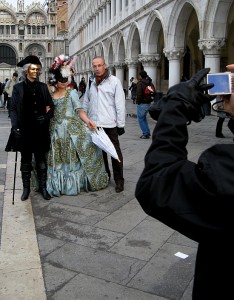
No special trains. This was a departure from past years and obviously creates more logistical misery for the revelers. Negotiations between the city and Trenitalia sputtered and died because nobody could reach an agreement on who would pay the bill for the extra service. Of course we already know that no ghe xe schei. Certainly not here, and evidently not at Trenitalia, either. Perhaps it’s under the potted palm.
The Grand Foyer: Now this was something new. When the partyers finally got to the Piazza San Marco, they discovered that 3/4 of the area had been closed off to form a sort of VIP area called the “Grand Foyer.” Depending on the day, the cost of a ticket to enter this realm ranged from 5 to 100 euros, and was offered as a very special way to enjoy proximity to the stage for the show(s) and some other perks. (Like seats on risers to watch the concert, or bags of confetti for 2.50). The organizers made no secret of their idea that this was intended as another way to make some of that missing schei, but so few people availed themselves of this opportunity– considering that they could see the show just as well from outside the fence — that eventually they let people in for free. (Does this remind you of anything? Peace and love, man.)
It’s true that you could dress up in an expensive rented costume (at least 200 euros) and attend a really glamorous party, like the one given at the Palazzo Pisani-Moretta on the Grand Canal. Tickets to that cost a mere 700 euros.
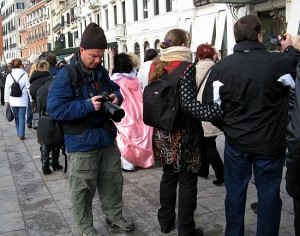
Or you could buy a mask and walk around taking pictures of people in masks and costumes. Or you could skip buying a mask and just walk around taking pictures. This seems to be what most people prefer.
We ran into a friend as we walked home Monday morning, and we indulged in a few choruses of a song which by now one knows all too well, the title of which could be “This isn’t Carnival, this is madness.” “People will do anything just to make money.” “Carnival is dead. Every year they just put more lipstick on the corpse.”
Naturally the city and its various Carnival-not-organizing components have already begun the spin. Speaking of how the Grand Foyer was working out, Piero Rosa Salva, the head of Venezia Eventi e Marketing, tranquilly described it as a sort of creative work-in-progress, an experiment. You can’t call an experiment a mistake, because, well, you’re experimenting. I myself can’t find a way to take seriously a project which could be labeled, “Let’s charge people lots of money for something they can get for free.” (Actually, I haven’t even tried to take it seriously.) But they’re still trying to understand why it didn’t work — so they can make it work better next time. Meanwhile, the private partners (Expo Venice and Attiva), which signed a three-year agreement with the city to share the cost of the stage, among other things, are probably already wondering what they were thinking.
Me, I’m always wondering what they were thinking.
